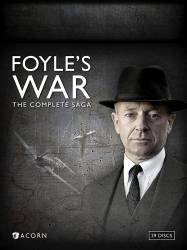Factual error: While this episode is set in 1946, early in the London street scenes a red Routemaster bus is prominently featured. The first of these buses was not delivered to London Transport until 1956.
Factual error: The episode takes place in 1946. Numerous scenes are shown in which the public buildings are clean. In 1946 they were soot streaked and grimy black and white from generations of coal fires and pollution. In addition one street scene has a street sign on a pole with a modern graphical notice on it rather than a worded notice of the time. Also, in the same scene the street name plate has a rather updated type face.
Continuity mistake: In the final scene when Miss Pierce in a car asks Foyle to get in, she looks rather more presentable initially with her hair in curls partly framing her face, with noticeable red lipstick and possibly make up. When Foyle gets in the car and takes up the conversation, the hairstyle reverts to her usual dowdy plain style off the face and the lips are natural.
Factual error: A number of the cars have number plates in which the numbers precede the letters, whereas at the time the letters came first.
Factual error: Eternity Ring is set in 1946. Samantha was accused of spying because she was seen with a man outside The Old Vic. She admits seeing a play there but not the play alleged (Henry V instead of The Cherry Orchard). The Old Vic was bombed in the Blitz and was closed from 1941 to 1950.
Factual error: Foyle is disembarking from a trans-Atlantic voyage from a ship which, in long shot, is painted in Union-Castle line colours. This line served African ports, not the USA. Their ships had lavender-coloured hulls from the mid-50s.
Factual error: The American flag shown has 50 stars, not the 48 stars that were on the flag at that time.
Factual error: SS officers did not carry a unit identification tattoo on the forearm, as implied in this episode. Most (but not all) carried a small, black, blood group tattoo under the armpit.
Factual error: Sunflowers are not grown in the North of France. They're grown primarily in Provence and Poitou.





